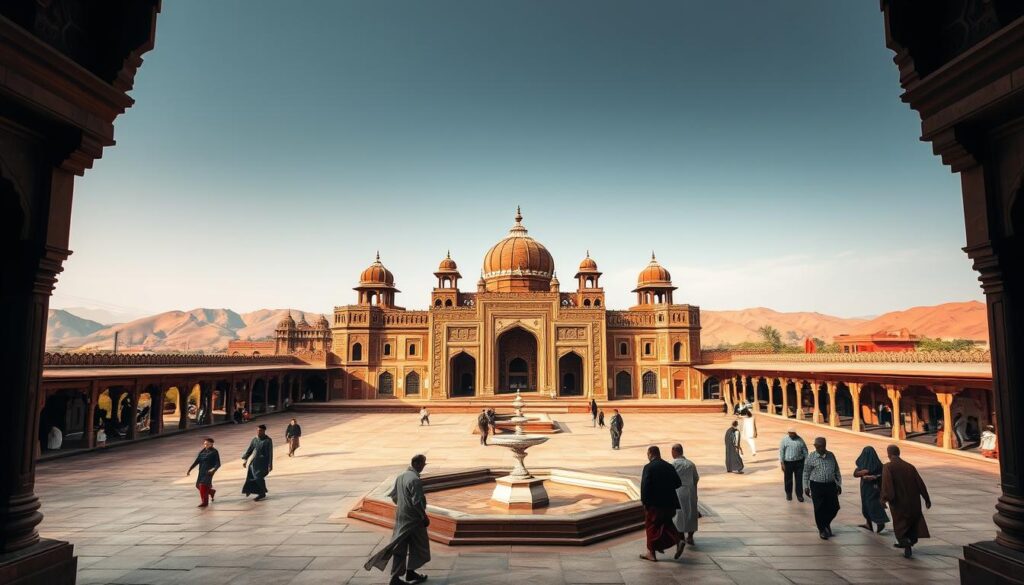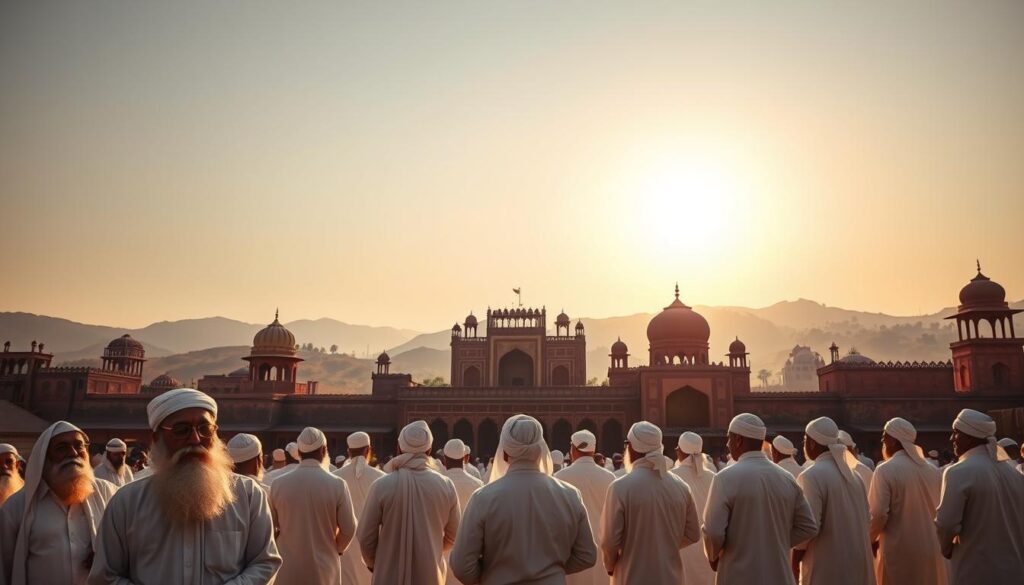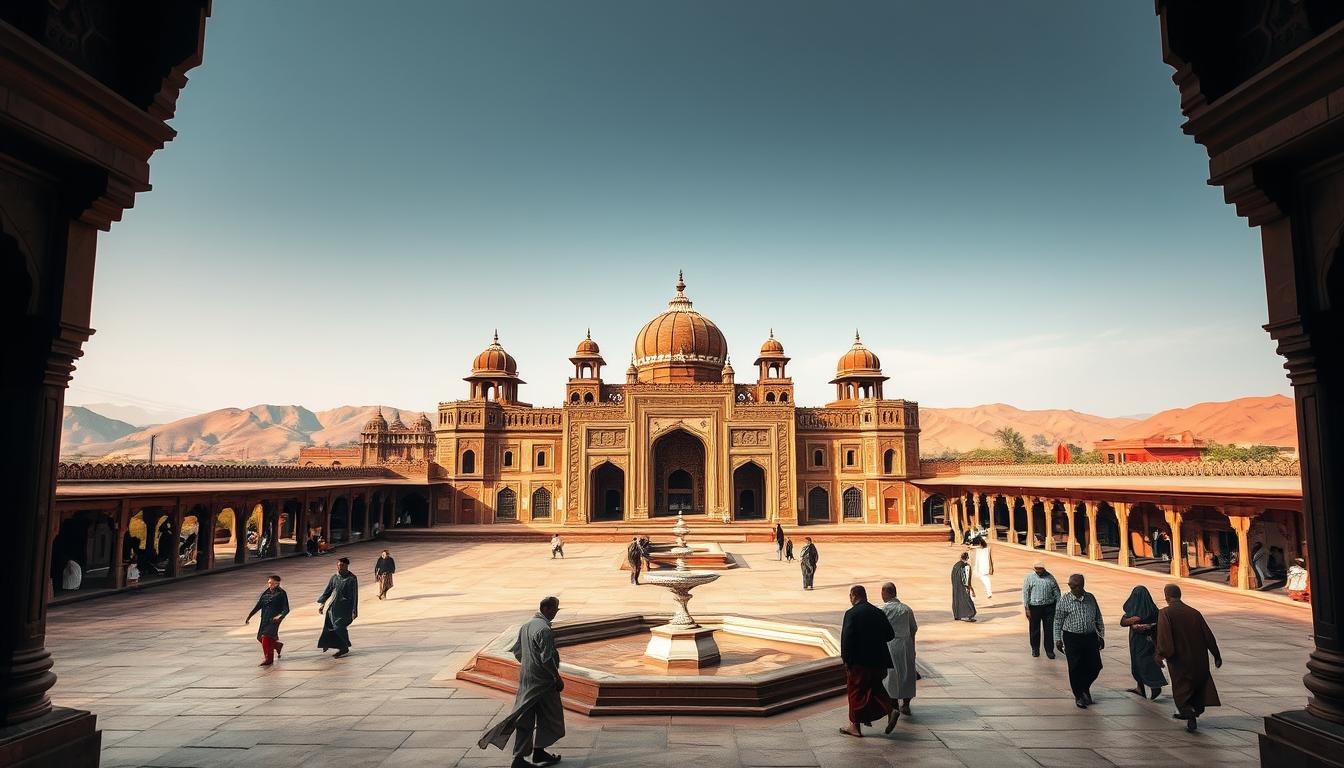What role did Sufi saints play in the establishment of Fatehpur Sikri: Explore the pivotal role Sufi saints played in the establishment of Fatehpur Sikri, a UNESCO World Heritage site in India.
Fatehpur Sikri is a UNESCO World Heritage site. It showcases India’s rich history and culture. Emperor Akbar founded it in 1571. It was the Mughal Empire’s capital from 1571 to 1585.

The city’s start is linked to Sufi saints. Sheikh Salim Chishti predicted Akbar’s son, Jahangir’s birth. This led to a religious compound for the saint, key in the city’s design.
We will look into Fatehpur Sikri’s history and the role of Sufi saints in its founding.
Key Takeaways
- Fatehpur Sikri was founded by Emperor Akbar in 1571.
- The city’s establishment is closely linked to Sufi saints, particular Sheikh Salim Chishti.
- Akbar’s son, Jahangir, was born in the village of Sikri in 1569.
- The city served as the capital of the Mughal Empire from 1571 to 1585.
- Fatehpur Sikri is a UNESCO World Heritage site, showcasing India’s rich cultural heritage.
The Historical Context of Fatehpur Sikri and Sufism
Fatehpur Sikri’s history is closely tied to Emperor Akbar’s reign and the rise of Sufism. The city’s creation shows the cultural and religious variety of the Mughal Empire under Akbar.
Emperor Akbar’s Vision and Challenges
Akbar had to overcome many hurdles. One was finding a new capital that would show his empire’s unity and diversity.
The Mughal Empire’s Expansion Under Akbar
Akbar’s rule saw the Mughal Empire grow a lot. It took in many regions and cultures.
Akbar’s Search for a New Capital
Akbar wanted a new capital. He wanted it to reflect the spirit of his diverse empire.
The Spread of Sufism in Medieval India
Sufism grew a lot in medieval India. The Chishti Order was a big influence.
Chishti Order’s Influence in North India
The Chishti Order focused on spiritual growth and tolerance. It shaped Akbar’s views.
Related Posts: Which hidden gems and lesser-known spots should I visit in Fatehpur Sikri?
Sufi Philosophy of Religious Tolerance
Sufism taught about living together and accepting each other. This idea influenced Akbar’s policies.
The Significance of Sikri Before the City
Before Fatehpur Sikri was built, the area was important. It was linked to Sufi saints.
| Historical Factor | Influence on Fatehpur Sikri |
|---|---|
| Mughal Empire’s Expansion | Cultural and religious diversity |
| Sufism and Chishti Order | Promotion of religious tolerance |
| Akbar’s Vision | Establishment of a new capital |
What Role Did Sufi Saints Play in the Establishment of Fatehpur Sikri?
The story of Fatehpur Sikri is closely tied to Sufi saints, like Sheikh Salim Chishti. We’ll see how these spiritual leaders shaped the city’s history and design.
Sheikh Salim Chishti: The Pivotal Saint
Sheikh Salim Chishti was a highly respected Sufi saint. His spiritual power and prophecy were key in Fatehpur Sikri’s creation.
Background and Spiritual Authority
Sheikh Salim Chishti was known for his deep faith and insight. His home at Sikri Hill became a place of pilgrimage for those seeking blessings.
His Hermitage at Sikri Hill
The hermitage, on a hill, was where Sheikh Salim Chishti meditated and guided his followers. Its peaceful setting helped in spiritual growth.
Relationship with Emperor Akbar
Emperor Akbar visited Sheikh Salim Chishti seeking a blessing for a son. This visit started a strong bond between the Mughal court and the saint.
The Prophecy and Birth of Prince Salim
Sheikh Salim Chishti’s prophecy about Akbar’s son was a turning point in Fatehpur Sikri’s history.
Akbar’s Pilgrimage to Seek Blessing for an Heir
Akbar went to the hermitage to ask for a male heir’s blessing. This showed his deep respect for Sufi saints.
The Miraculous Prediction and Fulfillment
Sheikh Salim Chishti predicted a son’s birth, which came true with Prince Salim (later Emperor Jahangir). This miracle proved the saint’s spiritual power.
Naming the Prince After the Saint
Akbar named his son Salim, after the saint. This act strengthened the connection between the Mughal dynasty and Sufism.
Other Sufi Influences on Fatehpur Sikri’s Design
Fatehpur Sikri’s design and architecture show Sufi principles and elements. This reflects the Mughal Empire’s diverse culture.
Architectural Elements Reflecting Sufi Principles
The city’s architecture includes Sufi mysticism symbols, like arches and domes. These represent the link between heaven and earth.
Religious Syncretism in City Planning
Fatehpur Sikri’s layout shows religious tolerance and syncretism. It has spaces for different religious practices, showing Sufi influence’s inclusiveness.
| Sufi Influence | Architectural Element | Symbolism |
|---|---|---|
| Sufi Mysticism | Arches and Domes | Connection between Heaven and Earth |
| Spiritual Authority | Hermitage at Sikri Hill | Site of Pilgrimage and Spiritual Guidance |
| Syncretic Culture | City Planning | Blend of Religious Practices |

The Lasting Legacy of Sufi Influence on Fatehpur Sikri
Fatehpur Sikri remains a key cultural and historical site. It shows the lasting impact of Sufi influence on the city. The Sufi influence is seen in the city’s architecture, cultural practices, and historical importance.
The Sufi saints played a crucial role in Fatehpur Sikri’s creation. The city’s design reflects Sufism’s spiritual and philosophical ideals. This connection is clear in the city’s layout.
The city’s cultural heritage is rich, with Sufi influence being a major part. Exploring the Sufism connection in Fatehpur Sikri helps us understand its history. It shows how Sufi saints shaped the city’s future.
The Sufi influence has made Fatehpur Sikri’s architecture and culture unique. It’s a place that fascinates visitors worldwide. The city’s legacy is a testament to the role of Sufi saints in its creation.
FAQ
Q: What role did Sufi saints play in the establishment of Fatehpur Sikri?
A: Sufi saints, like Sheikh Salim Chishti, were key in Fatehpur Sikri’s creation. They influenced Emperor Akbar to build the city.
Q: How did Emperor Akbar’s vision for Fatehpur Sikri reflect the cultural and religious diversity of his empire?
A: Akbar wanted Fatehpur Sikri to show his empire’s diversity. The Chishti Order’s focus on spiritual growth and tolerance guided him.
Q: What was the significance of Sheikh Salim Chishti’s prophecy regarding the birth of Akbar’s son, Jahangir?
A: Sheikh Salim Chishti’s prophecy about Jahangir’s birth was crucial. It made Akbar respect the saint and build Fatehpur Sikri.
Q: How has the Sufi influence on Fatehpur Sikri left a lasting legacy?
A: The Sufi impact on Fatehpur Sikri is still felt today. The city’s architecture, culture, and history continue to inspire.
Q: What is the historical significance of Fatehpur Sikri?
A: Fatehpur Sikri, a UNESCO World Heritage site, shows India’s rich history. It was the Mughal Empire’s capital from 1571 to 1585.
Q: How did the Chishti Order influence Akbar’s worldview?
A: The Chishti Order shaped Akbar’s views. It emphasized spiritual growth and tolerance, influencing his vision for Fatehpur Sikri.
Q: What is the continued relevance of Sufism in modern times?
A: Sufism’s impact on Fatehpur Sikri remains important today. The city’s culture and history are vital parts of India’s heritage.

My name is Radha Sharma and I live in Agra. I have started this first blog of my life Agrafast.in to make my future in blogging by watching videos of many big bloggers through the internet for a long time.

